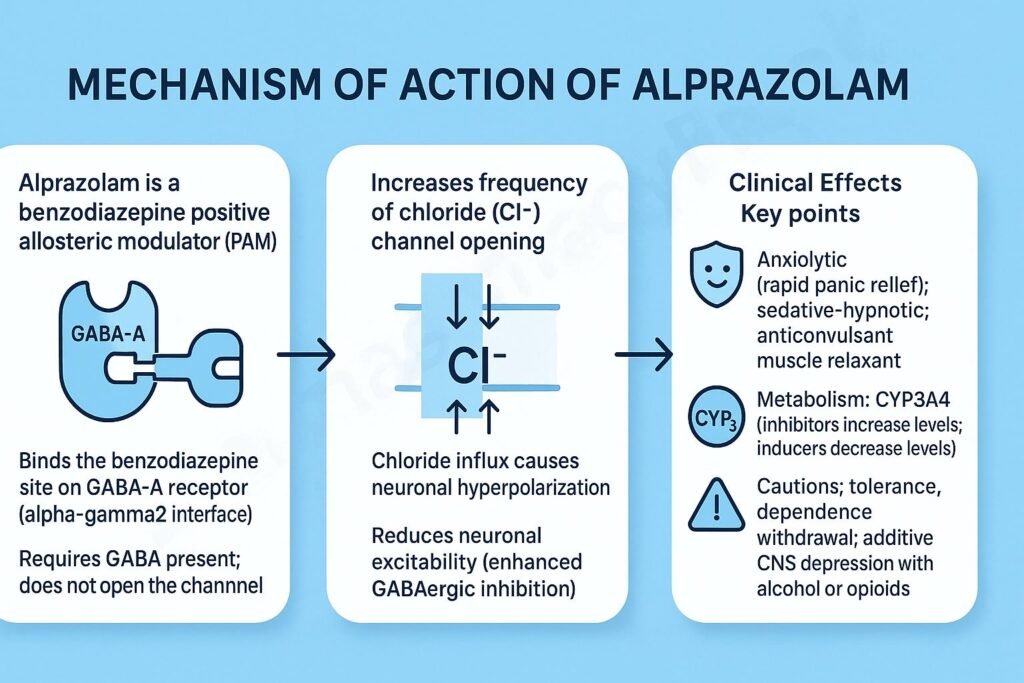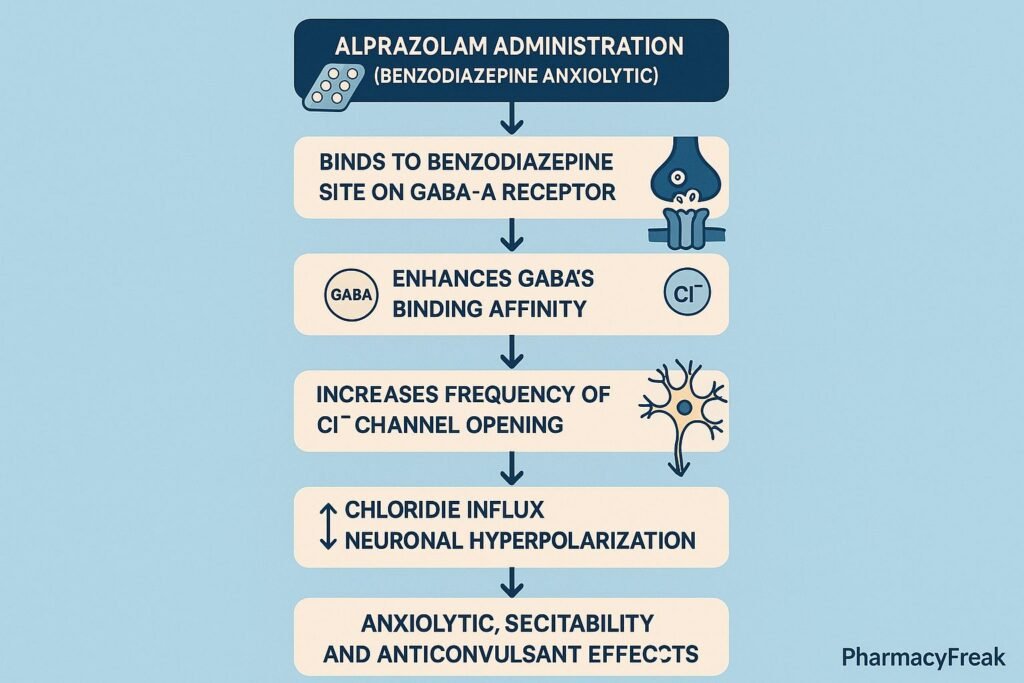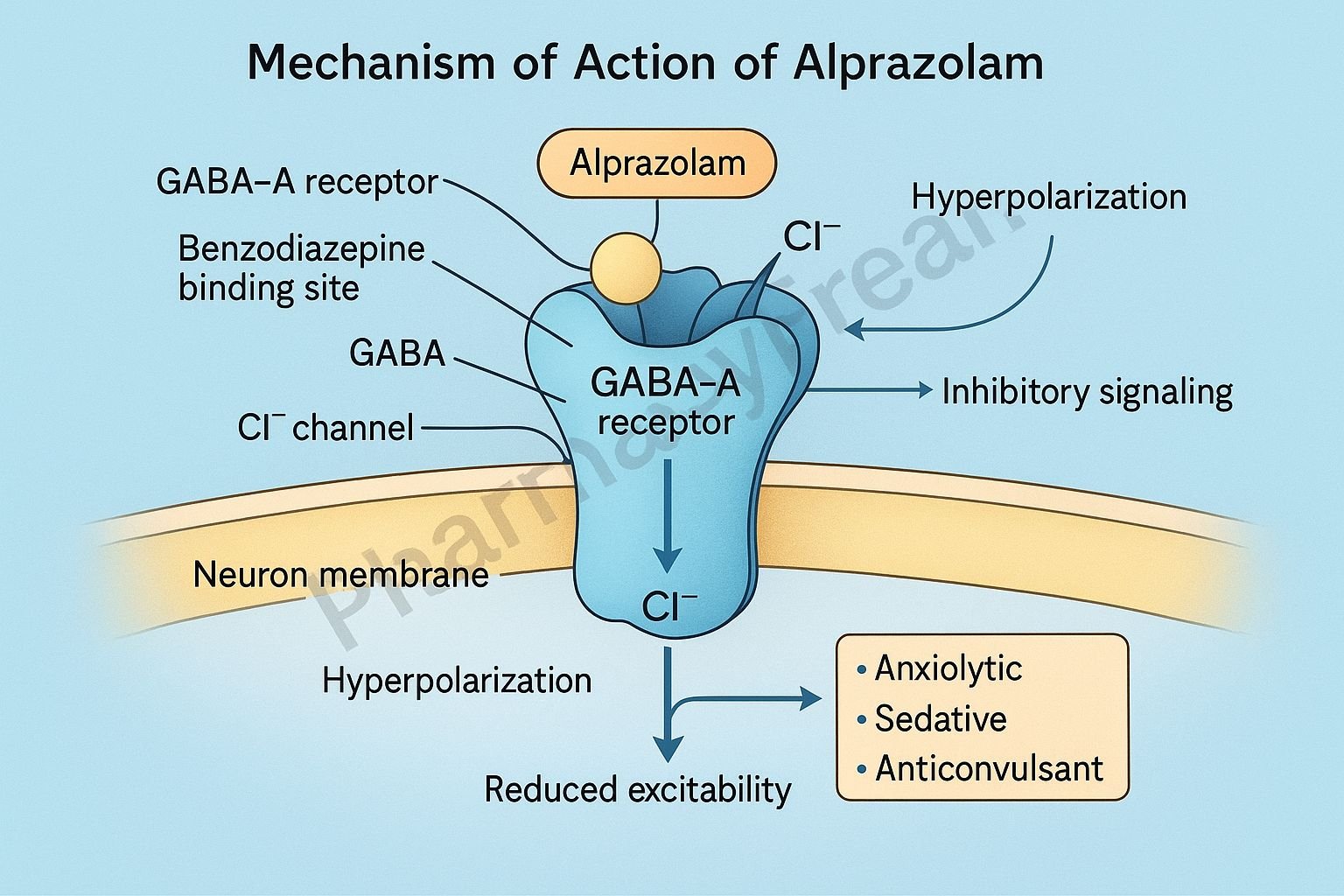Table of Contents
Introduction
Alprazolam is a short-acting benzodiazepine widely prescribed for anxiety disorders, panic attacks, and generalized anxiety disorder (GAD). Mechanism of Action of Alprazolam involves potentiation of the inhibitory neurotransmitter gamma-aminobutyric acid (GABA) at the GABA-A receptor, resulting in sedation, anxiolysis, and muscle relaxation. Known by its common brand name Xanax, alprazolam has a rapid onset and relatively short half-life, making it effective for acute anxiety management but also associated with dependence and withdrawal risks.
Mechanism of Action (Step-wise)
- Binding to GABA-A Receptors
- Alprazolam binds to a specific site located between the alpha (α) and gamma (γ) subunits of the GABA-A receptor complex in the central nervous system.
- This site is distinct from where GABA itself binds.
- Enhancement of GABAergic Activity
- When GABA binds to its receptor, it opens the associated chloride ion (Cl⁻) channel.
- Alprazolam increases the frequency of chloride channel opening, enhancing GABA’s inhibitory effects on neuronal firing.
- Neuronal Hyperpolarization
- The influx of Cl⁻ ions hyperpolarizes the postsynaptic neuron, making it less likely to fire an action potential.
- This leads to decreased neuronal excitability throughout the CNS.
- Functional Outcomes
- Reduced neuronal excitability produces anxiolytic, sedative, anticonvulsant, and muscle-relaxant effects.
- Overall Effect
- CNS Depression: Enhanced inhibitory neurotransmission via GABA.
- Therapeutic Benefits: Reduced anxiety, muscle tension, and panic symptoms.


Pharmacokinetics
- Absorption: Rapidly absorbed orally; peak plasma levels within 1–2 hours.
- Distribution: Highly lipophilic; crosses the blood-brain barrier easily.
- Metabolism: Hepatic metabolism via CYP3A4 to inactive metabolites.
- Excretion: Primarily via urine.
- Half-life: 10–15 hours (prolonged in hepatic impairment and elderly).
Clinical Uses
- Generalized anxiety disorder (GAD).
- Panic disorder.
- Short-term relief of anxiety symptoms.
- Adjunctive therapy in depression-associated anxiety.
- Off-label: Insomnia (short-term), pre-procedure sedation.
Adverse Effects
- Common: Drowsiness, fatigue, dizziness, cognitive impairment.
- Less common: Blurred vision, ataxia, hypotension.
- Serious: Dependence, withdrawal seizures, respiratory depression (with CNS depressants), paradoxical reactions (agitation, aggression).
- Contraindications: Severe respiratory insufficiency, sleep apnea, myasthenia gravis, acute narrow-angle glaucoma, and concurrent alcohol use.
Comparative Analysis
| Feature | Alprazolam | Diazepam | Lorazepam |
|---|---|---|---|
| Duration of action | Short-acting (10–15 hours) | Long-acting (20–50 hours) | Intermediate (12–18 hours) |
| Onset of action | Rapid (within 1 hour) | Rapid | Moderate |
| Metabolism | CYP3A4-dependent | Hepatic (CYP2C19) | Conjugation (non-CYP) |
| Primary use | Anxiety, panic disorder | Seizures, muscle spasms | Anxiety, insomnia |
| Risk of dependence | High (short-acting) | Moderate | Moderate |
MCQs
1. Alprazolam belongs to which class of drugs?
a) SSRIs
b) Benzodiazepines
c) Barbiturates
d) Antipsychotics
Answer: b) Benzodiazepines
2. Alprazolam acts on which receptor type?
a) GABA-A receptor
b) GABA-B receptor
c) NMDA receptor
d) Serotonin receptor
Answer: a) GABA-A receptor
3. The primary mechanism of alprazolam is:
a) Blocking dopamine reuptake
b) Enhancing GABA-A–mediated chloride influx
c) Inhibiting glutamate release
d) Activating serotonin receptors
Answer: b) Enhancing GABA-A–mediated chloride influx
4. The binding site of alprazolam is located between which subunits of GABA-A receptor?
a) Alpha and beta
b) Alpha and gamma
c) Beta and gamma
d) Delta and alpha
Answer: b) Alpha and gamma
5. Alprazolam increases the ______ of chloride channel openings.
a) Duration
b) Frequency
c) Conductance
d) Amplitude
Answer: b) Frequency
6. The metabolism of alprazolam occurs mainly via:
a) CYP2D6
b) CYP3A4
c) CYP2C9
d) CYP1A2
Answer: b) CYP3A4
7. Which of the following conditions contraindicates alprazolam use?
a) Hypertension
b) Narrow-angle glaucoma
c) Depression
d) Hypothyroidism
Answer: b) Narrow-angle glaucoma
8. Which is a serious adverse effect of alprazolam withdrawal?
a) Myalgia
b) Seizures
c) Constipation
d) Bradycardia
Answer: b) Seizures
9. The primary clinical use of alprazolam is:
a) Schizophrenia
b) Panic disorder and anxiety
c) Epilepsy
d) Mania
Answer: b) Panic disorder and anxiety
10. Which statement is true regarding alprazolam?
a) It blocks GABA binding directly.
b) It enhances GABA’s inhibitory action.
c) It antagonizes dopamine receptors.
d) It inhibits monoamine oxidase.
Answer: b) It enhances GABA’s inhibitory action
FAQs
Q1. Is alprazolam addictive?
Yes, prolonged use can lead to physical and psychological dependence; tapering is required when discontinuing.
Q2. What differentiates alprazolam from diazepam?
Alprazolam is shorter-acting and primarily used for panic disorder; diazepam has a longer half-life and broader indications.
Q3. Can alprazolam be taken daily?
It is prescribed for short-term use only; chronic use increases tolerance and dependence risk.
Q4. How does alprazolam differ from barbiturates?
Benzodiazepines increase frequency of GABA-A channel opening, while barbiturates increase duration.
Q5. Can alprazolam cause withdrawal symptoms?
Yes—abrupt cessation can cause anxiety, tremors, and seizures.
Q6. Is alprazolam safe with alcohol?
No, combining with alcohol can cause severe CNS depression and respiratory failure.
References
- Goodman & Gilman’s The Pharmacological Basis of Therapeutics
- Katzung’s Basic and Clinical Pharmacology
- Stahl’s Essential Psychopharmacology
- FDA Prescribing Information for Alprazolam
Related Internal Links

I am pursuing MBA in pharmaceutical management from NIPER Hyderabad with a strong academic record and proven success in national-level pharmacy entrance exams. I secured AIR 61 in NIPER 2024 (MS/M.Pharm) and AIR 27 in NIPER MBA, along with AIR 147 in GPAT 2024 and AIR 907 in GPAT 2023. I also achieved AIR 6 in AIIMS CRE-2025 for Drug Store Keeper and was selected as a Pharmacist (AIR 61) for ESIC. Additionally, I was the Runner-Up in Round 2 of the EY Case Study Competition.
At PharmacyFreak.com, I aim to guide future pharmacists through expert content, exam strategies, and insightful resources based on real experience and academic excellence.
Mail- harsh@pharmacyfreak.com
